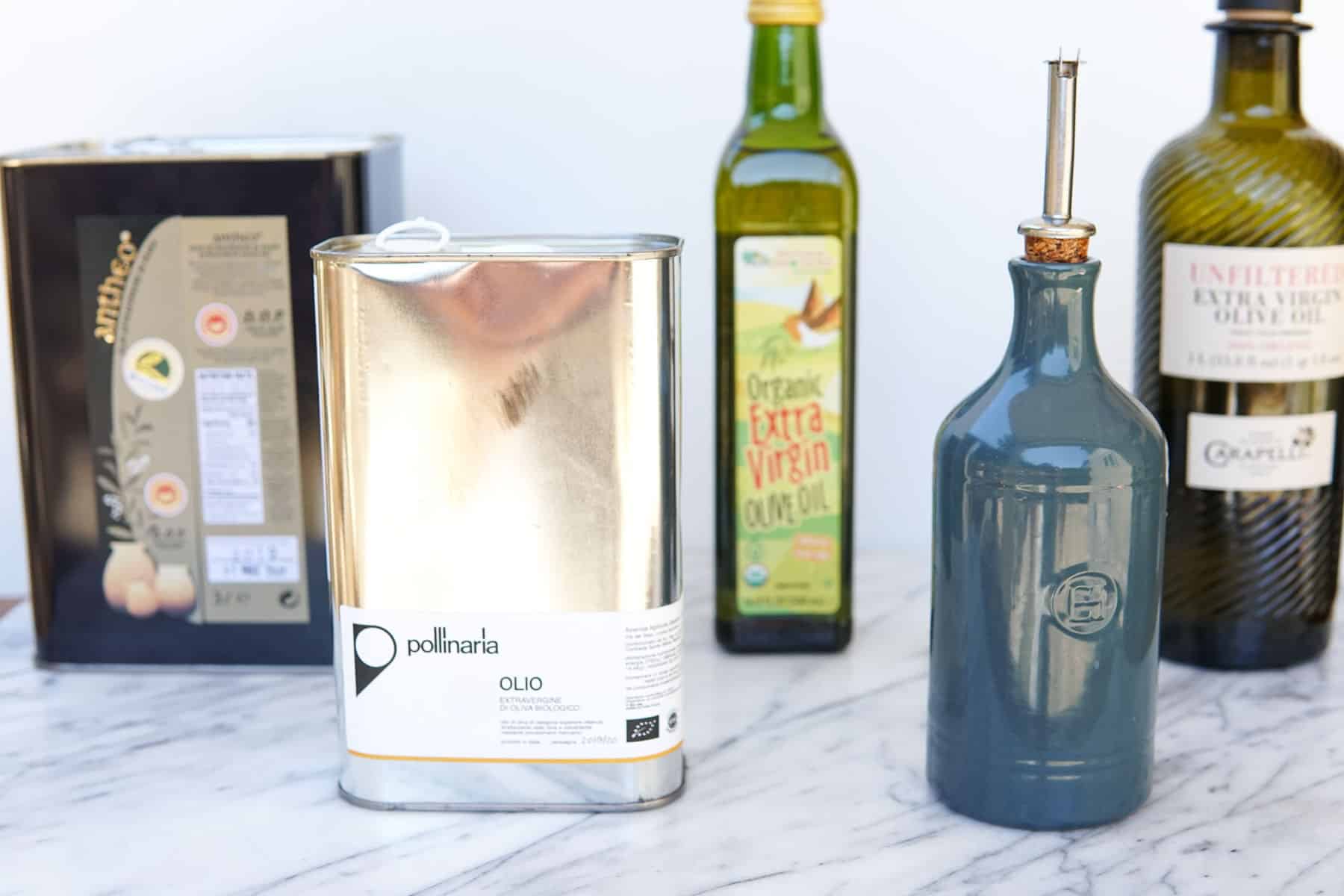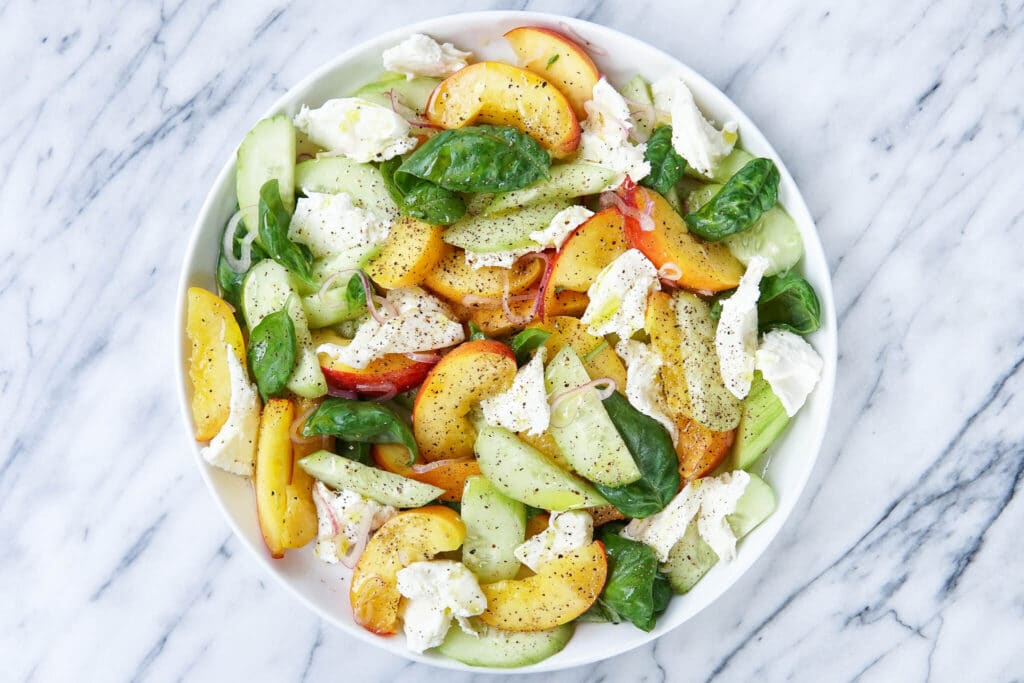Olive Oil 101

Olive oil has two purposes in my kitchen – to be cooked with and not to be cooked with. The oil you cook with is your everyday, less expensive olive oil. The oil you NEVER cook with is your “high quality” olive oil. These olive oils have a lot more flavor that come from a […]
Olive oil has two purposes in my kitchen – to be cooked with and not to be cooked with.
The oil you cook with is your everyday, less expensive olive oil. The oil you NEVER cook with is your “high quality” olive oil. These olive oils have a lot more flavor that come from a higher concentration of nutrients. This is the oil you use to drizzle onto grilled or raw seasonal veggies, to finish a pasta, or dip into with a piece of fresh bread. It will not only add an incredible amount of flavor and richness, but also a hefty dose of good-for-you polyphenols.
In the summer months, having a really good olive oil on hand is essential! This is when all of that beautiful, delicate, flavorful produce is available and doesn’t need anything more than a drizzle of oil, squeeze of lemon, and pinch of salt.
Now let’s learn a bit more about olive oil in general…
Tips for buying olive oil
The olive oil section at the grocery store is filled with different varieties from different countries and lots of different price points. So how do you know which one to buy? Here are a few things to keep in mind when picking out your olive oil.
Always buy extra virgin olive oil
Follow this rule at the very least. Extra virgin means it’s unrefined, chemical-free, and not treated or extracted using heat. While not all extra virgin olive oils are created equal, you’ll at least be getting the least refined (stay away from labels that just say “olive oil” or “light olive oil”, which are heavily processed)
Avoid olive oil that comes in clear glass or clear plastic bottles
Olive oil does not like heat or sunlight (or air), which is why they are usually packaged in opaque dark bottles or metal. Keep your olive oils in cool dark places!
Look for the country of origin
If you see a really cheap bottle of olive oil that is labeled “Product of Italy”, it’s likely that the olives didn’t actually come from Italy but were packaged there. It’s a sneaky little loophole that cheaper olive oil companies use to trick you! Good bottles should have the initials of the true country of origin (IT for Italy, PT for Portugal, GR for Greece, etc…). Or they will state in small print on the back “Product of _”. In general, it’s best to choose olive oil that comes from one place.
Check out the “best by” or “harvest” date
Every olive oil bottle should have a “best by” date on it, meaning the oil should remain an extra virgin until that date if stored properly. Some of the higher quality olive oils will have a “pressed on” or “harvest date” date on it, so you know exactly when it was harvested vs. when it was bottled. The more details the bottle gives, the better. This one isn’t always on the bottle, but it’s good to know. Olive oil does not get better with age!


The first photo is my cooking oil. Notice that one says “product of Spain” and the other has “PT, TN” (Portugal and Tunisia) as the country of origin. Both are fine, but if a bottle is super cheap and has a massive stamp on the front marketing “product of Italy”, that’s a reg flag. The second photo shows two high-quality olive oils that I bought in bulk on sale at my favorite olive oil shop in Portland. Both have expiration dates and harvest years, and clearly state the country and region of origin. The more details the better!
Health benefits of olive oil
It’s no secret that olive oil is good for you. It’s long been touted for it’s health benefits, specifically for inflammation and heart health. But let’s learn a little bit more about this magical golden liquid!
Olive oil is rich in a monounsaturated fat called oleic acid, which has been proven to reduce inflammation. About 73% of the oil is monounsaturated (mostly oleic acid) and about 13% is saturated fat.
Most importantly, olive oil is rich in antioxidants called polyphenols, more specifically a phenol oleocanthal. These phenols are what give olive oil its strong, bitter, pungent flavor. The combination of polyphenols and oleic acid gives olive oil its potent anti-inflammatory properties. This study showed that olive oil reduces the same enzyme in the inflammation pathway as ibuprofen.
It’s also largely been studied for heart health, specifically, its cholesterol-lowering and protective effects.
Some olive oils have higher polyphenol levels than others, so let’s talk about how you can figure that out (with your tastebuds!).
Why you should taste your olive oil
A good olive oil should taste and smell like grassy olives. The really flavorful oils will have a spicy, peppery flavor – an indicator that it is rich in phenols and polyphenols (see section above). If you don’t like that strong pungent olive oil flavor, you can find olive oils that are less intense but still have similar health benefits. However, it’s that bitter, peppery bite in olive oil that’s a direct indicator of the polyphenol levels.
If your oil tastes off, smells stinky, or tastes rancid, it’s probably been exposed to too much light, air, or heat and should be disposed of.

The only two olive oils you need
Extra virgin olive oil is great as a cooking oil. The only downside is that when you cook olive oil, a lot of that fresh virgin flavor will disappear. This is why I always have TWO olive oils on hand – one for cooking and one for finishing/drizzling/dunking.
1. Your everyday extra virgin olive oil
I am not too picky with the olive oil I cook with other than making sure it’s extra virgin and organic. I use the Kirkland brand organic extra virgin olive oil for my cooking.
However, I’m pickier with the olive oil I plan to dunk my fresh bread in or drizzle over salads. I pretty much always finish plates of pasta, soups, and salads with my higher-quality olive oil. It adds so much flavor and body and all you need is a little drizzle.
2. Your special extra virgin olive oil
I think it’s worth spending the extra money on a higher quality, more flavorful olive oil that you only use for drizzling. Since you’re not cooking with it every day or making big salad dressings with it, that bottle will last a long time (assuming you store it properly).
Also, when I’m making a super simple salad that just has greens and herbs or that beautiful summer produce in it, I will just drizzle on some vinegar or lemon juice and sprinkle on some salt, give it a toss, until the salad ingredients taste well seasoned (bright and just the right amount of salt). Then I drizzle my special extra virgin olive oil over top, give it a toss, and now you have a super simple salad that is packed with flavor from the olive oil and simple ingredients (it also helps to have good vinegar, but we won’t go there now).
My favorite high quality olive oils
Graza Olive Oil is my favorite oil because it’s sourced well and I love the squeeze bottles.
A few other good options:
- Olio Verde Extra Virgin Olive Oil
- Zoe Organic Extra Virgin Olive Oil
- Gaea Greek Extra Virgin Olive Oil
I also love this local Portland company where I used to get most of my good olive oils on tap. I believe they ship!
Recipes that use and highlight olive oil

Olive oil happens to also be great for baking – it adds a subtle savory flavor and lots of heart healthy monounsaturated fats. I should also note that one of my favorite ways to enjoy a good olive oil is generously drizzled over vanilla bean ice cream with a sprinkle of flaky salt.
Below are a few sweet recipes using olive oil:
- The BEST olive oil cake there ever was.
- Chocolate Olive Oil Cake
- Raspberry Rhubarb Olive Oil Muffins
- Strawberry Rhubarb Sauce with Maple Olive Oil Crumble
Below are a few simple seasonal salads to whip out your best olive oil for:
- Peach Cucumber Mozzarella Salad
- Blueberry Corn Goat Cheese Arugula Salad
- Melon Mozzarella Avocado Cucumber Salad
- Strawberry Avocado Cucumber Salad
So, I hope I’ve inspired you or convinced you to also have two different kinds of olive oil on hand. If you love a simple salad, soup, pasta or good bread (like me), it’s well worth it.


If you haven’t found it already, try Micucci’s store in Portland Maine for your newly local food source for olive oil and more!
Omg yes!! I love that store